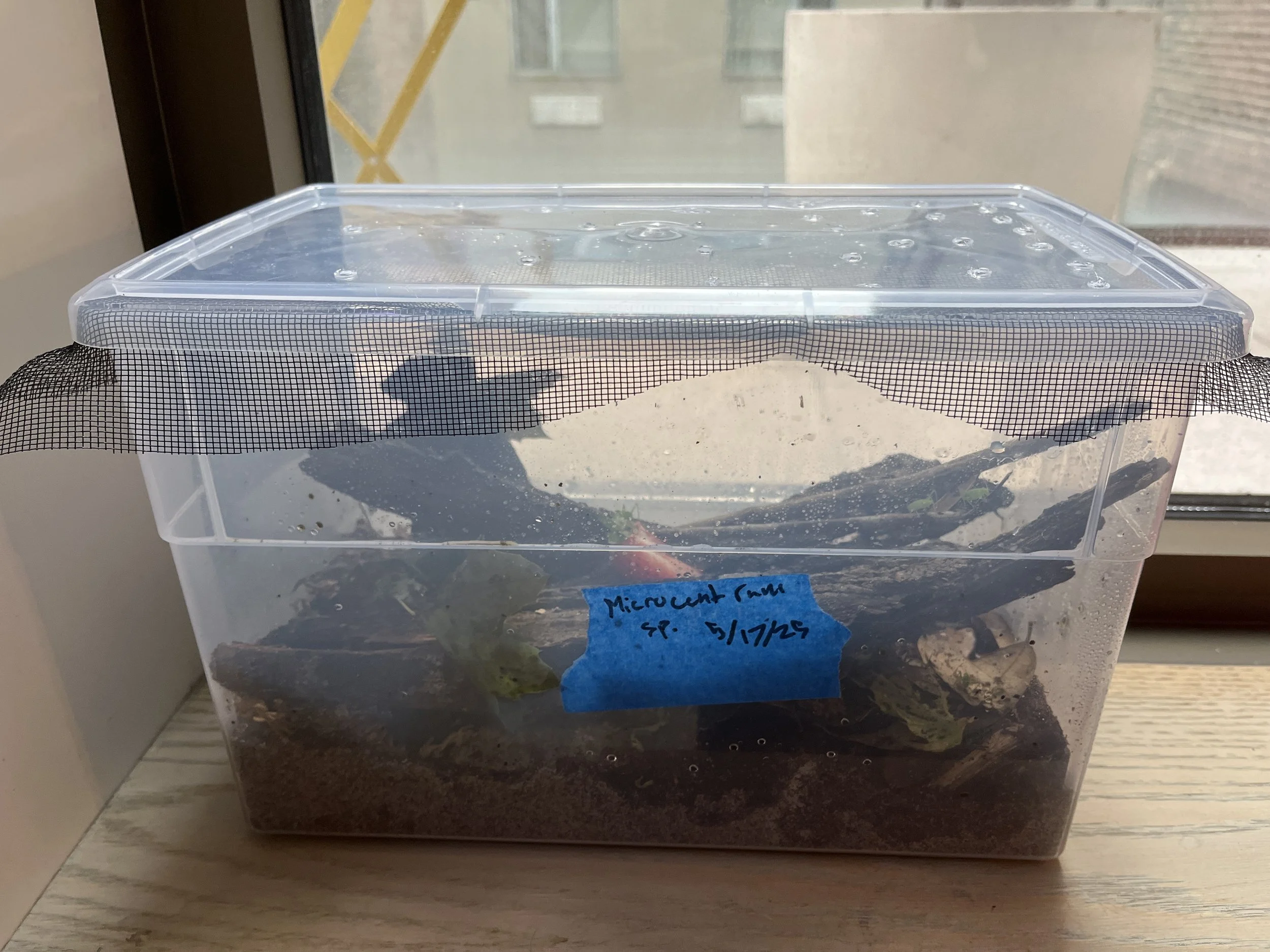The first of my many NY native Orthopteran breeding project posts!
Amblycorypha oblongifolia, the oblonged-winged katydid.
I collected this group of 8 or 9 Amblycorypha oblongifolia nymphs back on 5/17/25 and collected some more on 5/26/25. They range in size from roughly 1-1.5cm or 0.4-0.6in, so if I had to guess based on their size, probably L2 or L3 individuals (second or third instar) as they grow to around 5-6.4cm or 2-2.5in long.
I've been experimenting and feeding a bunch of different things. I've learned so far that they do not touch meaty, protein-heavy foods, such as bloodworm. However, I have had a lot of success with plant matter, a variety of leafy greens and vegetables that I had lying around in the kitchen, such as beet leaves, cucumber, strawberry, but by far the most popular is romaine lettuce and live maple leaves.
I am keeping all of these nymphs together in a 13 by 7 by 8.25in enclosure at the moment. I got around 0.75in of coco fiber substrate with a humidity gradient (one side with little ventilation and sphagnum moss, the other side with lots of ventilation), however, I have not noticed a preference between the two sides of the enclosure. I tried to make the best use of the space with some long pieces of bark and twigs, as well as leaf litter that allows the nymphs to climb and molt vertically. I also include a large population of springtails in the setup to control mold and other uneaten food. I think this setup should suffice until adulthood unless I collect more individuals.
Pterophylla camellifolia, the common true katydid.
I collected 2 nymphs back on 5/17/25, on the same trip, I collected the Microcentrum nymphs. Unfortunately, I haven't been able to find any more since, so I'm really hoping for a pair. I've been in contact with Kyle (roach crossing), who really wants this species and has been unsuccessful with them in the past. These two individuals are much larger than the Microcentrum nymphs, being around 2cm or 0.8in long, one being a bit larger and healthier than the other. I haven't witnessed any molts yet, but I assume they molt in the middle of the night and feed on their old exoskeleton before I see any evidence of a molt, as they seem to have grown since I first collected them.
I haven't noticed them really feeding on many things as they are nocturnal, but I have left similar foods with them as I had with the Microcentrum nymphs, which I believe they feed on (a variety of lettuce and some live maple leaves).
As there are only 2 individuals right now, I am keeping them in a 32-oz ventilated deli cup. I got around 1cm or 0.4in of coco fiber substrate, some small pieces of various native bark, dried leaf litter, and twigs. I also include a large population of springtails in the setup to control mold and other uneaten food. They both hand towards the top half of the container and seem to be fairing decently. I will probably move them to a larger container in their sequential molts as they get bigger.
Meconema thalassinum, the oak bush-cricket or the drumming katydid. Technically not a native species but a very well-established introduced species, native to Europe.
This is a rather common species in my area, I was able to collect over 10 of them on 5/24/25; however, unfortunately, I am down to 3 individuals. I believe they cannibalized each other as they haven't been eating. These 3 individuals are very tiny right now, maybe around 1cm or 0.4in long. M. thalassinum is a rather small katydid reaching only 2cm or 0.8in long as adults (not including the antennae).
Some sources claim that this species of katydid is purely carnivorous, feeding on small, soft-bodied insects such as aphids, while other sources indicate that M. thalassinum is omnivorous. Unfortunately, I haven't gotten them to eat so far (besides eating each other ). I've tried bloodworms, lettuce, deciduous tree leaves, and strawberries to no avail. I believe I saw one individual preying upon some grain mites in their enclosure, although this is not confirmed. Kyle suggested feeding some soaked seeds, such as sunflower or wheatgrass. I'm currently offering seeds that I got in the kitchen (pumpkin, sesame, and chia seed), although I will need to get my hands on some flightless Drosophila sp. or start a culture of pea aphids.
I got them in a very similar setup to the P. camellifolia. A 32oz ventilated deli cup, with around 1cm or 0.4in of coco fiber substrate, riddled with crushed leaf litter, bark, and tall twigs. I keep the setup rather dry, only spraying down every couple of days. I also include a large population of springtails in the setup to control mold and other uneaten food.






